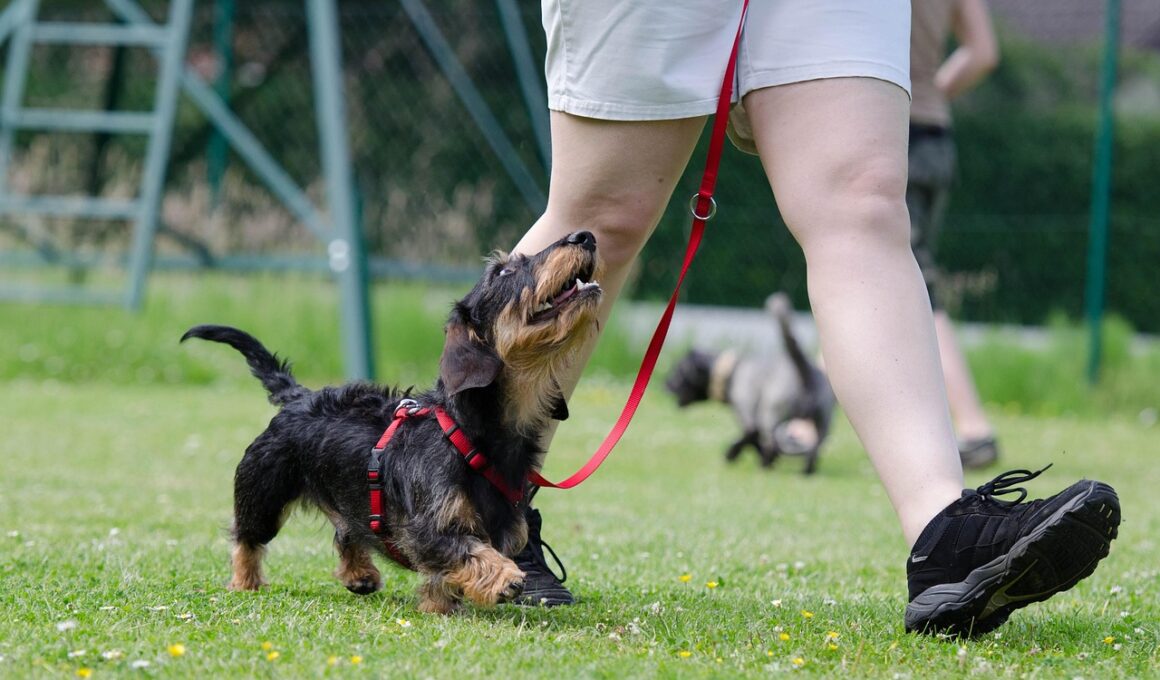How to Establish a Training Routine for Your Newly Adopted Dog
Adopting a dog is an enlightening and rewarding experience, but it comes with responsibilities. A well-structured training routine is essential to help your new furry friend integrate smoothly into your home. Begin by assessing your dog’s personality and behavioral traits. Each dog will have unique characteristics, so tailor your approach accordingly. A positive reinforcement method is highly recommended, utilizing treats, praise, and affection for encouraging desired behaviors. Make training sessions short and engaging, ideally lasting around five to ten minutes to keep your dog focused and motivated. After establishing a foundation, incorporate walking and socialization in your routine. Regular interactions with other dogs and people enhance social skills. Remember, consistency is key; train your dog at the same time daily to develop a habit. By providing structure, you nurture a trusting bond with your pet. Monitor your dog’s progress and be patient; every dog learns at their own pace. Celebrate small victories to motivate both you and your dog, which can make the journey of training more enjoyable. Overall, your commitment will pave the way for a successful transition into your family.
Monitoring your dog’s behavior during training is essential. Pay attention to their responses to commands and adjustments needed in your methods. Each dog has its learning style; some grasp concepts quickly, while others require repetition. Observe their enthusiasm and modify your approach accordingly. If they seem disengaged, switch activities or use different rewards. Incorporating playtime as part of training can nurture a fun atmosphere. After each session, end with a fun activity like fetch or tug-of-war. This helps reinforce your dog’s love for training while strengthening your bond. Additionally, be aware of your dog’s physical and mental limits during training sessions. If they show signs of fatigue, it may be time to take a break. Regular exercise should complement training to ensure your dog remains fit and focused. Schedule outdoor play or walks before training; a tired dog is often more receptive to learning. Be sure to vary your routines to prevent boredom. Introduce new commands and tricks as your dog masters previous ones. Variety maintains interest for both of you and creates excitement around training. Remember to celebrate milestones to keep motivation high.
Setting Realistic Goals and Expectations
When beginning a training routine, setting achievable goals is necessary for progress. Establish short-term and long-term targets based on your dog’s behavior and needs. Short-term goals create quick wins, which can boost your dog’s confidence and enthusiasm towards training. Focus on one command at a time to prevent overwhelming your dog, gradually increasing complexity as they master each task. For instance, teach basic commands like sit, stay, and come. Observe your dog’s performance and adjust goals as necessary to reflect their growing skills. Patience is essential during this process, as each learning journey takes time. Your expectations should factor in your dog’s age, temperament, and prior experiences. Puppies may need more repetition and socialization, while older dogs might adapt faster. Celebrating progress, no matter how small, also encourages your dog to engage further. Use a training journal to track milestones and areas that need improvement. This allows you to maintain a clear perspective on your dog’s growth and areas requiring attention. Finally, remember that setbacks can occur. Having realistic expectations helps manage your feelings and reinforces your dedication.
Engaging your dog’s mind during training will help improve their focus and obedience. Interactive toys, puzzles, and activities that stimulate your dog’s cognitive skills are beneficial. Incorporating these items into your routine promotes engagement. Spend time teaching your dog tricks; this strengthens the bond between you while keeping their mind sharp. The excitement of learning new tricks can be an excellent way for them to look forward to training. Use commands that are consistent and distinct, ensuring your dog clearly understands what you expect from them. Positive reinforcements, such as praise and treats, play a significant role in reinforcing learned behaviors. Gradually fade out food rewards by transitioning to verbal praises as your dog becomes proficient. Frequent breaks during training are vital. Giving your dog several minutes to relax and process what they have learned can greatly enhance their retention. Revisit commands periodically; revisiting fosters a sense of security in your dog. It validates that learning never stops. Frequent practice reinforces good behavior and deepens your connection, establishing a sense of routine. Creating this balance ensures a smoother and more enjoyable experience for both of you.
Socialization and Exposure to Different Environments
Socialization is just as crucial as basic training when setting up a routine for your newly adopted dog. Expose your dog to various environments, people, and other animals. Gradual introductions are key; this allows your dog to adjust comfortably. Arrange playdates with well-mannered dogs to improve social skills and reduce anxiety during interactions. Visit pet-friendly spots to expose your dog to greater stimuli, helping them learn how to adapt. Aim to integrate these experiences into your training sessions. For instance, practice commands in new locations, reinforcing behavior while providing social exposure. Remember, positive experiences lead to well-adjusted dogs. If your pet seems apprehensive, listen to their fears and take small steps to address them. Never force interactions; allow them to approach at their own pace. Consistent exposure helps alleviate anxiety and promotes confidence in your dog. Include training as part of your daily walks; combining socialization with obedience training builds discipline in various settings. Your leadership will ensure your dog feels secure in these unfamiliar environments, making training more effective. Prioritize safety by supervising encounters and maintaining control, giving both you and your dog peace of mind.
Understanding your dog’s body language is vital for effective training. By recognizing signs of stress, fear, or excitement, you become a more effective trainer. Look for cues such as tail position, ear orientation, and posture to gauge their comfort levels. This understanding enables you to intervene when needed, ensuring the training environment remains positive. Equip yourself with knowledge about dog behavior and techniques to alleviate any anxieties. Methods like gentle guidance, using calming signals, and allowing breaks can create a comfortable atmosphere fostering success. Employing a calm demeanor during training also impacts how your dog responds to commands. Your energy directly influences their behavior, so remain patient and composed. When frustrations arise, take a step back and reassess your approach. Often, a change in perspective or technique can lead to breakthroughs, helping your dog feel more secure. Moreover, varying your training environments ensures your dog remains flexible and adaptable. Mix familiar and unfamiliar settings to challenge them while building confidence. Remember, your dog relies on your guidance and support, so remain their mentor throughout the process. In the long run, this commitment to understanding your dog will lead to a rewarding training experience for both.
Ensuring Consistency and Patience
Building a solid training routine requires consistency and patience. Dogs thrive on routine and benefit from a predictable schedule. Establish specific times for training each day, aligning it with your dog’s natural energy levels. Morning sessions may work well for energetic dogs, while evenings might better suit calmer pets. However, flexibility is essential; adjust training times based on daily needs while maintaining a consistent overall approach. Repeat commands using clear, concise cues to reinforce understanding. As your dog learns, incorporate training into daily life. Enforce basic commands like sit or down before meals, during walks, or playtime. These moments forge connections and reinforce training organically. Maintain a positive atmosphere throughout training; a happy dog is a receptive dog. Keep your tone encouraging and provide ample praise for achievements, big or small. Remember that every dog learns at their own pace. Some may grasp concepts quickly, while others may take more time. When progress stalls, adjust your expectations and remain patient. Celebrate your dog’s perseverance, reinforcing your bond. Ultimately, a consistent and patient training approach paves the way for a harmonious relationship.
Your training routine can significantly impact your adopted dog’s success at home. The bond built during training establishes trust and respect, key ingredients for a happy, well-adjusted pet. Regularly assess your routine for effectiveness and adjust as needed. As your dog continues to learn and evolve, encourage them to develop beyond their initial training. Explore advanced tricks or agility courses if your dog shows interest and aptitude. Creating a goal-oriented training environment can foster motivation, not only for your dog but for you as well. Remember that setbacks and challenges are normal; adapt your strategies and stay committed. Involve family members in the training process to unify your dog’s experience. This ensures everyone is aligned and implements consistent commands, enhancing your dog’s learning. Regular interaction creates a strong family bond with your puppy, which is essential for their emotional development. Moreover, consider consulting professionals if you face persistent challenges. They can provide insights tailored to your unique situation. Overall, consistency, adaptation, communication, and love will lead to a rewarding and successful journey with your newly adopted dog.


